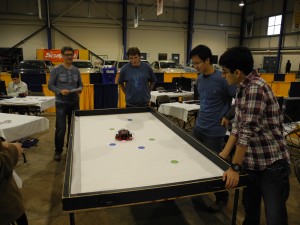Studica was again host for this year’s Third Annual Virtual Robotics Challenge at the Ontario Technological Skills Competition – OTSC 2012 held on April 30 – May 2, 2012 in Waterloo, Ontario. Ten teams participated in this year’s challenge where the competing teams were required to program a fischertechnik Robo-TX Explorer robot using the latest recently released Microsoft Robotics Development Studio 4 (that you can get as a free download)
 Using the Visual Simulation Environment of the MSRDS, the students were given the task of programming the Fischertechnik Services available in the Microsoft Visual Programming Language (MVPL). Participants skills ranged from second-time entrants, to novices that were previously never exposed to programming or robotics. Programming in the MVPL is unlike conventional procedural languages like C, C++, or Java. Instead, the MVPL uses the Concurrency and Coordination Runtime, (CCR), and the Decentralized Software Services (DSS), to generate events from the various services of the robotics hardware which can be acted upon using the many objects and components available in the MVPL. By simply using drag-and-drop, diagrams and activities are easily created by connected the various nodes on the screen. This approach is easily grasped by non-programmers. There is also an option to use C# for hard-core programmers.
Using the Visual Simulation Environment of the MSRDS, the students were given the task of programming the Fischertechnik Services available in the Microsoft Visual Programming Language (MVPL). Participants skills ranged from second-time entrants, to novices that were previously never exposed to programming or robotics. Programming in the MVPL is unlike conventional procedural languages like C, C++, or Java. Instead, the MVPL uses the Concurrency and Coordination Runtime, (CCR), and the Decentralized Software Services (DSS), to generate events from the various services of the robotics hardware which can be acted upon using the many objects and components available in the MVPL. By simply using drag-and-drop, diagrams and activities are easily created by connected the various nodes on the screen. This approach is easily grasped by non-programmers. There is also an option to use C# for hard-core programmers.
The first part of the task was to program the robot to follow a line. However, the robot was required to first find the start of the line, follow the path to the end, turn around, and go back to the beginning, and then blink a light three times to signal completion and stop. Eight out of the ten teams were able to complete this task and four of the teams then moved on to successfully program and run the real fischertechnik Robo-TX hardware using the PC and a Bluetooth interface. The final part of the challenge was for the hardware robots to wander around the court and to detect random color discs placed around the court and blink a preset number of times per detected color. Two teams succeeded in completing this task successfully. The winner of the competition was determined by various components including approach and design of the algorithm, and speed, reliability and accuracy of the line follower.
The challenge was exciting for participants, judges, and spectators. Many participants were fascinated by the fact that the robots were programmed and controlled by the computers using the freely available MSRDS software from Microsoft. The robot’s behavior was autonomous whereby once the program was started, the robot seemed to behave on its own as there was no physical connection to the computers. Next Year’s competition will certainly involve more fischertechnik hardware and a much more difficult challenge level. More information will be posted on the fischertechnik site www.fischertechnik.biz.
Take a look at some pics from the show:
Share this Post



